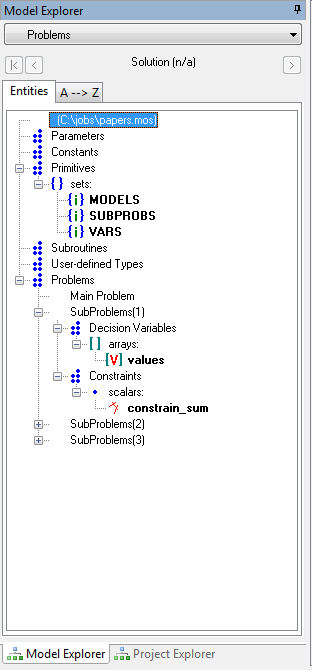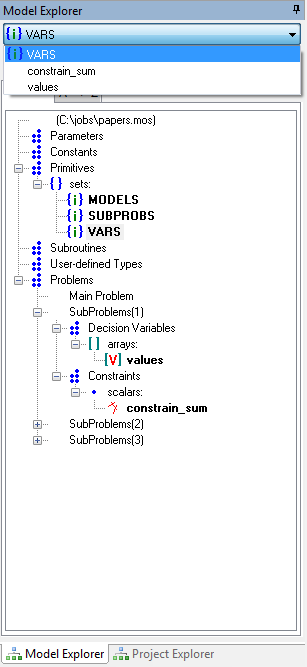The Model Explorer Bar showing the entity tree
Can be shown/hidden by selecting Model Explorer Bar from the View menu or by clicking the ![]() icon on the Project pane.
icon on the Project pane.
The Model Explorer Bar contains the entity tree, the A->Z entity list and the most recently accessed entities combo list:
 |
 |
 |
After the successful compilation of a Mosel model, the entity tree will be populated with identifiers from the model. After a successful execution of the model, the values of the identifiers appear in tooltips when the mouse is nearby. The complete values can be examined by double clicking on an identifier (which will open the View text dialog). If a model is being solved for multiple solutions, then the controls under recently-accessed entities list can be used to select a given solution (the best solution is chosen by default).
The identifiers are grouped in the following categories:
Parameters
Parameters can have the same type as Mosel primitives, but they are special entities as they can be used to pass information to a model without having to edit it.
Constants
Constants also have regular primitive types, but their values cannot change at runtime.
Primitives
These are primitive types (integer, real, boolean, string) either standalone or grouped into sets or arrays.
User types (defined within Mosel modules) will also appear here. Refer to the Mosel Native Interface documentation for details on how to define and use such external types.
Note that if user types do not support conversion to/from text, the values shown here will be meaningless.
Subroutines
A list of all the functions and procedures defined in the current model.
Problems
The main Mosel problem, and any other variables containing problem objects (which can be selected in model by use of the Mosel with statement). In the example images above, the model contains an variable called SubProblems, an array of 3 mpproblem objects.
Those entities which are displayed specific to a given problem are:
Decision variables
Representing the special mpvar Mosel type, decision variables are characterized by solution value and reduced cost after a successful optimization.
Linear constraints
Representing the special linctr Mosel type, linear constraints are characterized by activity value, slack and dual value after a successful optimization.
Note that decision variables and linear constraints will only display correct values if the optimization was successful and a solution was found.
© 2001-2019 Fair Isaac Corporation. All rights reserved. This documentation is the property of Fair Isaac Corporation (“FICO”). Receipt or possession of this documentation does not convey rights to disclose, reproduce, make derivative works, use, or allow others to use it except solely for internal evaluation purposes to determine whether to purchase a license to the software described in this documentation, or as otherwise set forth in a written software license agreement between you and FICO (or a FICO affiliate). Use of this documentation and the software described in it must conform strictly to the foregoing permitted uses, and no other use is permitted.

